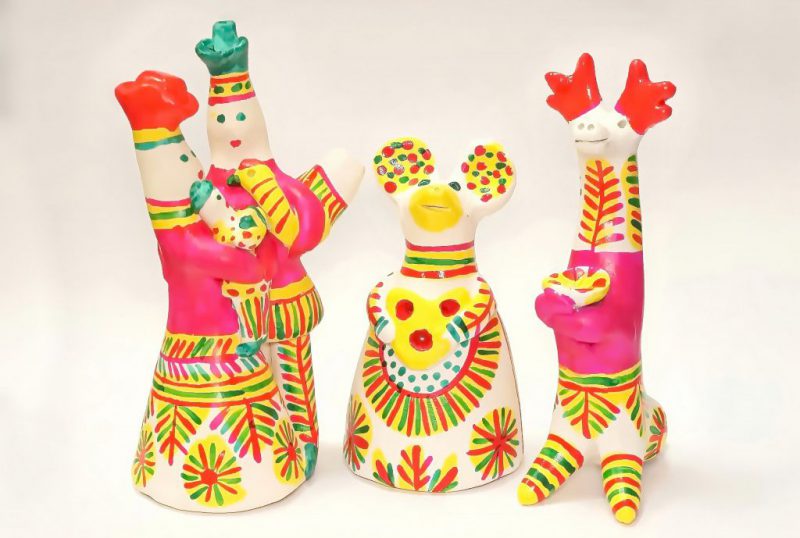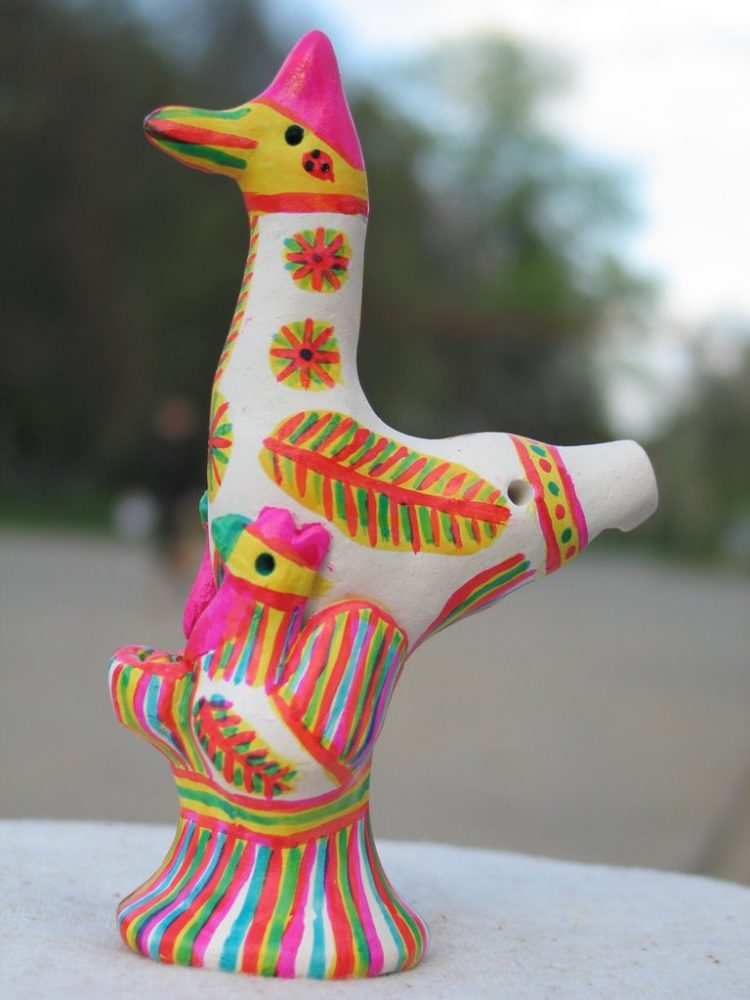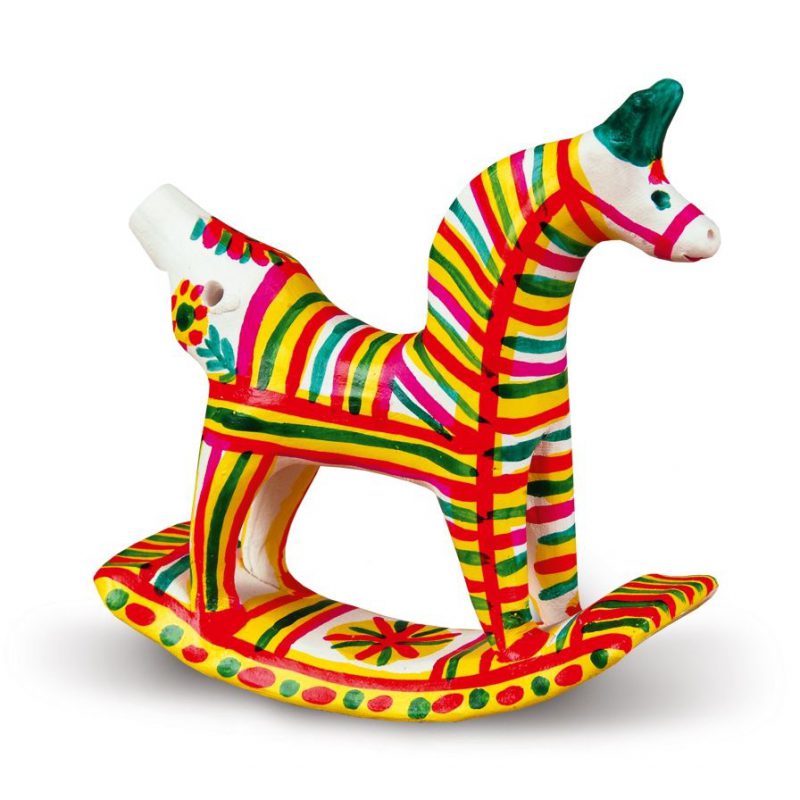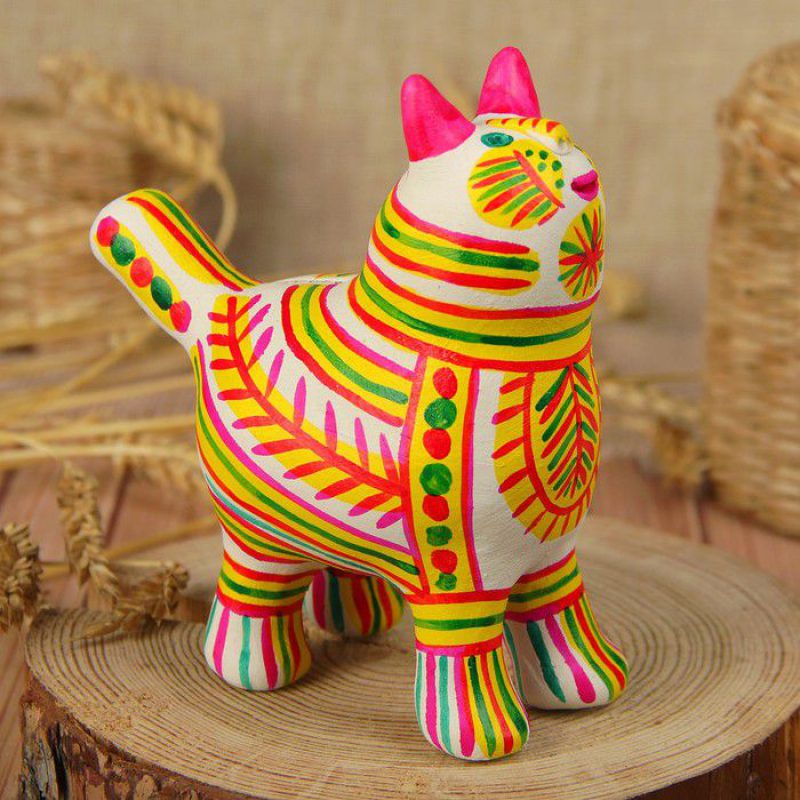Filimonovo Toy – Hand-made Clay Whistles
Filimonovo toy production is one of the oldest Russian folk-art crafts. The birthplace of the Filimonovo toy is the village of Filimonovo in the Tula region.

History of the Craft
The village of Filimonovo was mentioned for the first time in the annals of the 16th century. Legend has it that its name derived from the the potter Filimon: He was the first one to find deposits of soft clay in this area. This clay started to be used to mold kitchen dishes, chimneys and various household utensils.
This region was poor, yields were scarce, and so the sale of clay pots and bowls became the only source of income for the villagers. In order not to throw away pieces of clay left after production of bigger items, the villages started making small whistles out of them. And this is how the Filimonovo toy was born.
At first, all the whistles were simply given out to children, but villagers soon started to sell them at fairs.
While pottery was made by men, the toys were exclusively made by women. Girls started to learn the craft at the age of seven: Grandmothers passed the secrets of the craft to their granddaughters and all the revenue earned from the sale of whistles was put aside in the dowry of the young craftswoman.
By the middle of the 19th century Filimonovo toys became popular in other regions. Yet, the 1917 Revolution almost wiped out the craft: There were only a few women in the village who continued to practice this art. In the 1960s, these craftswomen taught their art to several art historians and collectors. Young artists then learned these folk techniques, and by the 1980s, the art of Filimonovo toys had finally revived.

Types of toys
Most often, masters depicted people and animals, and sometimes multi-figure compositions such as “tea party”, “carousel”, “on a bench”, and so on.
The shape for the toys was very simple, without small details. Male and female figures had a narrow and short body with a thin waist which transformed into voluminous pants or fluffy skirts. The conical head did not differ in width from the neck and was crowned with a headdress – a scarf or a hat for female characters and a cap or a hat for men. Female figures were holding a baby or a bird-whistle, and male ones – a rooster or a goose.
Bears, horses, cows and deer were most common amongst animal characters. The shape of their horns or ears was different, but the remaining proportions were almost the same: A thin elongated body with smooth bends, slender legs, a long neck and a small head.

Production Features
To make the whistles, the craftswomen used soft, non-greasy clay that had a dark blue color. First, the clay was kept for several days in a damp, cool place. Then women knead it with their bare feet on a wooden floor. The finished clay was then cut into plates and stored, covered by a damp cloth.
A toy was always molded from a single piece of material. Small cracks and irregularities were smoothed out with a wet hand, so the shape of the product became elongated and smooth. Finished figures were finally baked in a special furnace. After baking, the clay changed color to pinkish-white.
Interestingly enough, until the middle of the 19th century, Filimonovo toys were not painted. Then aniline dyes appeared: They were diluted with egg white or yolk, then the finished product was painted with bright patterns and dried. However, such paint quickly faded, and by the 1870s, masters had replaced the egg with acetone, which helped the coating to be more resistant.
Only three colors were used for painting the toys: yellow, red-raspberry and green. In the old days, they were given symbolic significance; It was indeed believed that yellow represents air and the sun, red represents warmth and beauty, green represents spring and life. The paint was applied with a chicken feather in a strict order: Firstly a background of wide yellow stripes and circles was created. The part of the whistle that was supposed to be touched by the lips was not painted. Yellow paint was applied to the skirts and aprons of the ladies, the pants of the gentlemen, the neck and sides of the animals, as well as the wings of the birds.
Then thin stripes, circles, dots, and other simple ornaments were painted with red or raspberry paint, starting from the center, on a yellow background. The shirts of the characters were painted the same color. When the paint had dried up, green strokes were applied in-between the red patterns. The faces of the toys were not worked out in detail: they just outlined a red mouth, and green eyes-dots.

Filimonovo Toys Today
The craft in the village of Filimonovo is still alive today thanks to a few families that continue the artistic traditions of the ancient craft. The toys are still made by hand, although baked in electric furnaces where the temperature reaches 950 degrees Celsius. The aniline dyes and acetone have been replaced by bright, persistent and harmless acrylic which is applied with brushes of different thicknesses made of animal fur (although some craftsmen use the old-fashioned chicken feather). The plots of toys are diverse, there are more than fifty different items, but the stylistic features developed by the many generations of folk artists remain unchanged.
In 2009, not far from the village of Filimonovo, in the city of Odoev, the first and only museum in Russia of Filimonovo toys was opened. Its exhibition presents not only local products, but also other folk crafts – Romanovskaya, Sudzhanskaya, Voronezhskaya and Kozhlyanskaya toys, as well as copies of Greek clay figures from 1400–1100 BC.. The museum hosts lectures on the history of fishing, as well as workshops on modeling and painting whistles.
Since 2013, the festival of pottery and clay toys “Tales of Grandfather Filimon” is held anually in Odoev. Masters from different parts of the country bring traditional toys and designer ceramics from their home regions. In addition to clay products at exhibitions and fairs, festival guests can see and buy lace, national costumes, and sweets prepared according to old recipes.
You can visit the official site of the Filimonovo Toy (only in Russian) here: https://filimonofskay-igrushka.ru/. There, it is possible buy a traditional Filimonovo toy, as well as artistic works: caskets, pictures, small sculptures (delivery only over Russia).






